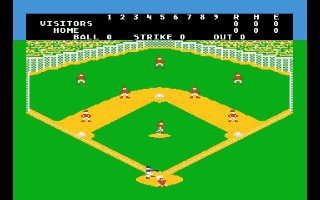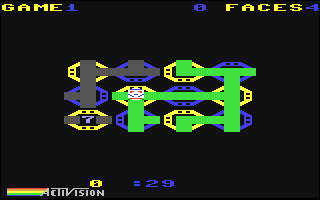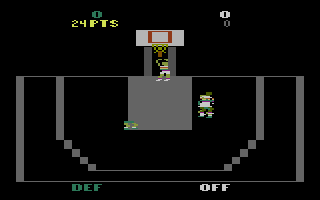

... Matthew Hubbard
By Scott Stilphen
DP: What factors led up to you working for Atari, and what was your first game for them?
Matthew Hubbard: I got my bachelor’s degree in Math (CS minor) from Cal State Hayward in 1978. My first job out of college was at AMI, a chip manufacturer in Sunnyvale. I applied for work at Atari soon after, and got the job largely because of a recommendation from Prof. Jim Daley of CSUH, who was on the Atari advisory board. A funny coincidence happened with getting the job at Atari. I got two letters from them on the same day, one saying, “Thanks for sending the resume, but no thanks” and one asking me to come in for an interview. After the interview, I got two more letters on the same day, another saying thanks but not thanks and one giving me a job offer. My soon-to-be boss Dennis Koble was very apologetic about the snafu.
The first game (and the first game programming) I did was Submarine Commander. I was given a choice of projects to do from a list, and one was to take Air-Sea Battle and “update” it, using 4K (instead of 2K).
 DP:
It appears based on
Midway’s classic Sea Wolf (of which I am a big fan), although you added
some great features. Was this your inspiration for it?
DP:
It appears based on
Midway’s classic Sea Wolf (of which I am a big fan), although you added
some great features. Was this your inspiration for it?
Matthew Hubbard: I tried to make it a different game and I succeeded to some extent, but I honestly don’t think it’s very good
DP: How was it that this ended up being a Sears exclusive title (even though it says “Atari” on the screen)?
Matthew Hubbard: Marketing didn’t have much confidence in it. It may be the best of the Sears exclusive titles, but that’s kind of like being “The Tallest Midget In Texas” - not really that much of an honor.
DP: I also noticed that the “1” in the “©1982” date is different from the normal font. Why was this?
Matthew Hubbard: For the same reason that the “RI” letters in ATARI aren’t as wide as the “ATA”; we had to save space. To make that look better would have cost 24 bytes for graphics that would not have been used anywhere else in the game. Back in those days we couldn’t be wasteful of bytes, and Atari management wasn’t fussy about those kinds of details.

DP: I understand that you started work on RealSports Baseball for the 5200, but someone else finished it. Was this because you had left to go to Activision? Do you know who else worked on this game?
Matthew Hubbard: I only started the Baseball project before heading to Activision; I believe Jim Andreasen finished it.
DP: You joined Activision in 1982. What prompted you to leave Atari?
Matthew Hubbard:
Artistic freedom. I didn’t like the work atmosphere at
Atari after Rob Fulop and others left for Imagic. The boss, Steve Wright, and I
never got along, and the prevailing attitude among the programmers was that it
was okay to do drugs at work. (I don’t want to act like I was Nancy Reagan or
anything; I sometimes went outside and smoked the herb with others, but I got
tired of it.) Activision was a much more professional atmosphere, and they
expected programmers to come up with their own ideas.
The week I left for Activision, management at Atari got wind that there was
going to be an exodus of programmers to yet another startup. (They got wind
because I told them. I had interviewed at this place and they left clear hints
that Howard Warshaw and Tod Frye were soon to be on board.) So on the day I was
to go to Activision to find out what they would offer me, there was a meeting at
Atari to announce a royalty plan; everyone who had a game that was soon to be
released got an advance check of $30,000 or $40,000, depending on whether the
game was either an Atari or Sears exclusive. So with a $30,000 check in my
pocket and a promise of a “substantial” raise the next day, I went to Jim Levy’s
office at Activision, and he offered me a job at about a 20% raise from what I
was making at Atari and I agreed on the spot. The next day, Atari offered me an
80% raise. I said no and gave them back the $30,000. While they didn’t make me
sign anything, I felt the check was a request for me to stay, and it would have
been dishonest to take it and then leave.
 DP:
How did the idea
for Dolphin come about?
DP:
How did the idea
for Dolphin come about?
Matthew Hubbard: I wanted to make a game where the main characters were a little bigger than normal on the 2600, using double-size mode and line-by-line single pixel shifting. I experimented with making a dolphin animation, and everyone who saw the early screens knew immediately that the pixels represented a dolphin, so I moved forward from there.
DP: It’s one of the few games that have an actual message for extremely high scores. Most Activision titles stop at 1 million and display “!!!!!!”. Was there a specific reason for stopping the score at 300k?
Matthew Hubbard: I thought 300k was going to be unreachable. It was a matter of less-than-rigorous play testing, and is entirely my fault.
DP: Did you realize that some players have found it’s possible to just jump over the walls and ignore trying to swim through the holes?
Matthew Hubbard: I didn’t think about players jumping over the sea horses, and if I had, I would have fixed it.
DP: There’s also a well-known trick with Dolphin. After achieving the “Amazing!” message, the 2nd player will be awarded 10 free dolphins (if his game already ended)! If you kill off the 10 dolphins you’ll receive 100! A 2nd “Amazing!” can be achieved, after which the 1st player game ends and you’re left with the 2nd player. Was this something that was intentionally programmed?
Matthew Hubbard: No, just another programmer/tester error.

DP: Zenji was rumored to be slated for the 2600. Did you work on it? Was it ever finished?
Matthew Hubbard: I started Zenji on the 400/800. It was not planned to be 2600 game, and I never worked on any port of it to any other system. All the ports were done by others.
DP: Double Dunk is easily the best of the 3 known basketball games for the 2600. Were you originally planning on doing a version of EA’s One-on-One?
Matthew Hubbard: I hate to disagree with someone giving me a compliment, but I think the 2k Atari Basketball cart is much more fun to play. This was an assignment job to do a two-on-two game
DP: You have a clever “work-around” for making a round ball. Were there any programming tricks or features that you were especially proud of?
Matthew Hubbard: I did my best given the circumstances, and I put in some cute bells and whistles, but the good video games of that time are all about game play, and I was never as good at that as the recognized masters, such as David Crane, Alan Miller, Bob Whitehead, Steve Cartwright, Rob Fulop, and others.
 DP:
How did working
with Atari again come about? Were you a sub-contractor for them, or an
employee?
DP:
How did working
with Atari again come about? Were you a sub-contractor for them, or an
employee?
Matthew Hubbard: I sub-contracted on Double Dunk. I needed the money.
DP: Were the games that you wrote ones that were chosen or assigned? How long did it take you to program each?
Matthew Hubbard: Of my released games, only Dolphin and Zenji were truly original works; everything else was assigned. Each game took 9-12 months.
DP: Are there any Easter eggs in any of your games? Any bugs/glitches?
Matthew Hubbard: Lots of bugs and glitches; very few Easter eggs.
DP: Were there any games that you started, but didn't finish or get released? Also, do you recall any other titles that others were working on but weren't released?
Matthew Hubbard: I worked on a Commodore 64 game for Activision called Queen Bee; it never saw the light of day, which is probably just as well.
DP: Did you go to Electronic Arts after leaving Activision?
Matthew Hubbard:
After I was laid off at Activision in December 1984, I was
on the TV game show, Jeopardy!, where I won $25,550 and of course, some fabulous
parting gifts. I took a year off and went back to work - first at Apple in
testing, and then I bounced around a little and got back into games. I worked at
EA, LucasArts, and two startups - Futurescape and Northstar Studios.
While at EA, I (briefly) worked with Dani Bunten (of M.U.L.E. fame) for a few
weeks on the update to M.U.L.E., before the project was canceled. She was very
nice. I once told her that she and the other transsexuals in the game business
should make a comic book about their work and call it "The Ex Men". She thought
that was funny.
DP: Are you still involved in game design? What have you been involved with (up to the present)?
Matthew Hubbard:
I still design board games and card games, but not
computer games. None of mine have been published yet, but I'm currently in
discussions with Steve Jackson Games about a chess variant called Three Kings.
I also teach math at CSUH as a lecturer, and I’m in the process of getting my
Master’s in Math from CSUH, after which I plan to get a Doctorate.
DP: How was it working for Atari and Activision? Any stories from those days?
Matthew Hubbard: Both companies were a lot of fun in their day. I made more friends among the programmers at Atari, but the overall atmosphere at Activision was much nicer. One of my favorite memories of Atari was in my first few months working there. I started late in the year, October or so, and Dennis Koble took me aside and told me I wouldn’t be getting a bonus, but not to take this as an insult. They liked me but I hadn’t been around long enough. I’d probably get a gift certificate for a ham or turkey. I wasn’t concerned about it. I had just left a job where the week after Christmas was a forced vacation, and at Atari it was a week off with pay. Well, the day for bonuses rolls around, and I get an envelope with a window. Funny place to put a gift certificate, I thought. It was a check for $500! It’s kind of silly to think about it now, given how much money would be thrown around in the industry in the proceeding years, but I don’t think I have ever been happier getting a check than I was that day. Bob Polaro, Rob Fulop, Dave Johnson and I piled into Dave’s Mustang (known as the Inter-Continental Ballistic Mustang) and headed up to Lake Tahoe for the weekend, without so much as stopping at our houses for a change of clothes (I was wearing white overalls with a silk tie!). Carla Meninsky used to call those of us who gambled on poker and backgammon “The Scumbags”, so this was the 1st Scumbagathon. It was terrific fun.
An Activision story I remember happened during a vacation in Boston. I was at the New England Aquarium - wearing a Starmaster jacket - and there was a field trip of school kids. One of the kids asked me if I played Starmaster, and if I was any good at it. I told him I worked at Activision, and his eyes got as big as saucers! I had a crowd of kids following me around for the rest of the day, making suggestions as to what game I should design next. I’ve often said that being a video game designer was like being a rock star, except that all the groupies are 13-year-old boys, which doesn’t do me any good at all.
DP: Do you ever see any of your former programming co-workers?
Matthew Hubbard: No. Someone from Activision got in touch with me just this week, and he told me there was a rumor going around that I was dead! I thought this was very funny and asked him if the rumor specified how I died. He said there were no specifics, which is too bad. I was hoping I’d been shot by a jealous husband.
DP: What are some of your favorite games, or types of games?
Matthew Hubbard: I play more board games and card games now than computer games. On the computer, I’ve usually enjoyed abstract games like solitaire, Tetris, Lemmings, etc. My favorite 2600 games are probably Kaboom!, Skiing, and Stampede.
DP: What's your opinion on the state of gaming (arcades and consoles) today?
Matthew Hubbard: I don't play (video games) much, but I think the dance games are a clever idea.
| GAMEOLOGY |
| GAME | SYSTEM | COMPANY | STATUS |
| Submarine Commander | Atari VCS/2600 | Atari | released |
| RealSports Baseball (started) | Atari 5200 | Atari | released |
| Dolphin | Atari VCS/2600 | Activision | released |
| Zenji | Atari 400/800 | Activision | released |
| Queen Bee | C-64 | Activision | not released |
| Defenders of Dynatron City | NES | LucasArts | released |
| Double Dunk | Atari VCS/2600 | Atari | released |
| M.U.L.E. (updated version) | EA | not completed | |
| Road Rash II | Genesis | EA | released |